Arusha National Park Day Trip: The Perfect Safari in Tanzania
A day trip to Arusha National Park is an ideal solution for those travelers who have a short stay in the northern part of Tanzania and want to visit a place with a memorable safari. The park is a self-contained gem of nature, located approximately 25 kilometers (about 16 miles) northeast of Arusha city but with widely diverse scenery, fauna, and adventure. In contrast to the bigger parks of Tanzania, Arusha National Park is the perfect location for those running against the clock who still desire indulging in the wilderness.
From the sweeping views of the majestic summit of Mount Meru and bewildering misty woods that harbor black-and-white colobus monkeys to the glittering Momella Lakes that are brimmed with flamingos, this park is a never-ending pleasure to the senses. No matter why you are visiting, like taking a walk with giraffes, a canoe safari, or a hike to the waterfalls, the park provides great sights of biodiversity and scenic landscape without long travel time. To the nature lover, photographer, and adventurer, this day trip will be a really rewarding experience in Tanzania.

Embark on a mesmerizing journey to Arusha National Park, Tanzania’s captivating haven of magnificent wildlife, diverse landscapes, and adrenaline-pumping adventures
- Where is Arusha national park located in Tanzania?
- Best time to visit Arusha national park
- Arusha national park entry fees
- Gates of Arusha national park and opening hours
- How to get to Arusha national park
- What to do in Arusha national park?
- Practical Tips for Your Arusha National Park Day Trip
- Conclusion
Where is Arusha national park located in Tanzania?
The Arusha National Park is found in the northeastern corner of Tanzania, which is only 25 kilometers (roughly 16 miles) east of Arusha city and 60 kilometers (37 miles) north of Kilimanjaro International Airport. Spread among the tall mountains of Mount Kilimanjaro and Mount Meru, the park is part of the Arusha region and one of the most easily accessible safari venues in northern Tanzania.
It is strategically located to attract visitors who might be arriving in Arusha and are usually in need of a short scenic wildlife exposure without having to travel long distances as compared to the big parks in the Tarangire or Serengeti. But despite its small size, Covering about 552 km², Arusha National Park is small compared to Tanzania’s other parks but incredibly varied, boasting dense montane forests, crater lakes, open grasslands, and the striking Ngurdoto Crater. Regardless of whether you are about to start or complete your northern safari circuit, this park provides serene and enchanting scenery with the abundance of flora, fauna, and breathtaking views.
Best time to visit Arusha national park
The best time to visit Arusha National Park is during the dry seasons, June to October alongside December to March. These seasons are when the weather is the best, with clear skies, comfortable temperatures, and the best conditions for a viewing of wildlife and trekking. Wildlife usually congregate around water sources during the dry season, making it easy to spot animal species like giraffes, zebras, buffaloes, various primates, and others.
For birdwatchers and green thrill seekers, the short rainy season of November–early December, and particularly the long rains of March to May, are still worthwhile as the park turns brilliant with color and migratory birds are plentiful.
Nevertheless, visiting during the cool rainy season in northern Tanzania is not recommended due to heavy rains, extending between April and May. Torrential rains may cause flooding of the paths, slippery roads, and inability to see much wildlife because of the thick vegetation and lack of visibility. Certain sections of the park might prove to be inaccessible, and traveling might be marred by incessant showers.
In all, no matter which kind of adventure you want to experience (a game drive in the wild, a canoe ride, or a hike), your visit to Arusha National Park can be set up any time of the year with the help of proper planning.
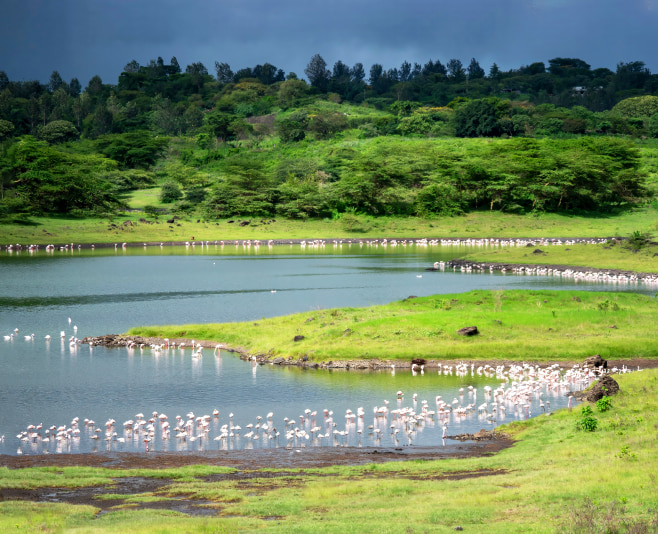
The best time to spot wildlife is during the dry season from June to October.
Arusha national park entry fees
Park Entrance Fees (Per Person, Per Day)
|
Visitor Type |
High Season |
Low Season |
| Non‑East African Adult (> 16) | $50 | $45 |
| Resident/Expat (> 16) | $25 | $22.50 |
| East African Adult (> 16) | TSh 10 000 | TSh 10 000 <- flat year-round |
| Child (5–15) – non‑EA | $15 | $15 |
| Child (5–15) – resident/EA | $7.50 (EA), $7.50 (Resident) | $7.50 / $7.50 |
| Under 5 | Free | Free |
The high season runs from June to October and from December to February, while the low season is from March to May during the long rains.
Note: Entrance fees are subject to an additional 18% VAT as required by Tanzanian law. For example, a Non-East African adult fee of $50 becomes $59 including VAT.
Walking Safari Fees (Guided Nature Walks)
|
Walk Type / Age |
Fee (Non‑EA & Resident) |
| Short walk (1–4 hrs) | $20 |
| Long walk (> 4 hrs) | $25 |
| Child (≥ 12 yrs) | $10 (short) / $15 (long) |
These are ranger‑guided walks in the park’s forest and crater areas
Cycling Fees
| EA CITIZEN (KSHS) |
Non-EA Citizen
(US$) |
Expatriates/
Residents Living in Tanzania (US$) |
| 30,000 | 25 | 25 |
Gates of Arusha national park and opening hours
The Arusha National Park has two major gates through which visitors normally access the park; the park has several attractions.
- Momella Gate: This gate is found on the eastern side of the park and is the gate commonly used by the visitors to access the Momella lakes, whereby they have to canoe, or the visitors who have started their treks to Mount Meru. It is the entry point of the Momella route of climbing Mount Meru.
- Ngongongare Gate: It is one more important gate that is located on the southeastern border of the park. It is strategically situated close to the mini Serengeti open grassland where animals usually graze during mornings. Ngongongare Gate is also an administrative point where a visitor can obtain information about the park and obtain permits, and there could be facilities such as TANAPA (Tanzania National Parks Authority) offices, toilets, and a souvenir shop.
Opening hours:
- The park is open every day between 6:00 AM and 6:00 PM, similar to the general rules of Tanzania national parks.
- We should mention being allowed to enter into the park during the daylight hours only and planning to leave the park before closing, since staying in the park overnight is permitted only to visitors who will have made a reservation in the lodge or on a camping site.
- Game drives or even such activities as walking safaris are most recommended to be done in the early mornings, with the cool weather conditions giving one the best opportunities for game sightings.
Whether entering through Ngongongare or Momella, guests are greeted with efficient check-in processes and helpful staff ready to assist with park information and permits.
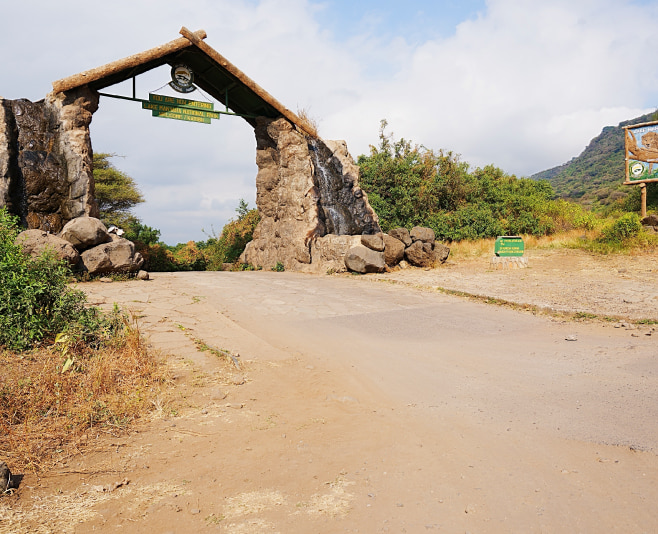
Arusha National Park Gate is your gateway to a world of natural wonders in Tanzania.
How to get to Arusha national park
A day trip to Arusha National Park is both epic and surprisingly easy to arrange since it is so close to one of the largest and busiest safari centers in Tanzania. The park, located approximately 25 kilometers (15 miles) northeast of the town of Arusha, can be accessed with ease whether in the course of a day trip or as a take off point in more extensive northern circuit exploration.
By Road:
Arusha National Park is accessible by road, and most people take that mode of transport, and the route is relatively smooth. Leaving Arusha town, the main park grade will be on the paved Arusha-Moshi road; after a drive of 20-25 minutes, you will take a left turn to the two main gates leading into the park: Ngongongare Gate in the south (the southern entrance) and Momella Gate in the northeast (the northeastern entrance). Transfers can be booked with tour operators, or a traveler could hire a personalized vehicle; better make it a sturdy 4x4. During the rainy season, some inner park roads can become muddy or slippery, making a 4x4 vehicle highly recommended for safe and smooth travel
Visitors entering the park through Kilimanjaro International Airport (JRO) is approximately 35 to 45 kilometers from Arusha National Park, depending on the chosen route, and can be reached by car in 45 minutes to 1 hour, which makes it a perfect first or last destination on the northern circuit itinerary.
By Air:
Arusha National Park has no airport of its own, so there are two alternative ways of getting there. Travelers can fly into Kilimanjaro International Airport or the smaller Arusha Airport, serving regional flights only to Dar es Salaam, Zanzibar, and other domestic destinations. The park gates are not far away from either airport.
Public Transport:
Public minibuses (daladalas) exist between Arusha town and villages close to the park area, which cost little to persons on a limited budget. Nevertheless, they do not go inside the park's surrounding area, and reaching the park gates from the drop-off points may require hiring a taxi or a motorbike taxi (boda-boda). Although being cheap, this choice does not work as well and is not suited to people with tight schedules or larger luggage.
Arrival in Arusha National Park is easy whether you choose to travel on your own or use a guided safari since you can explore various attractions in the park without wasting time.
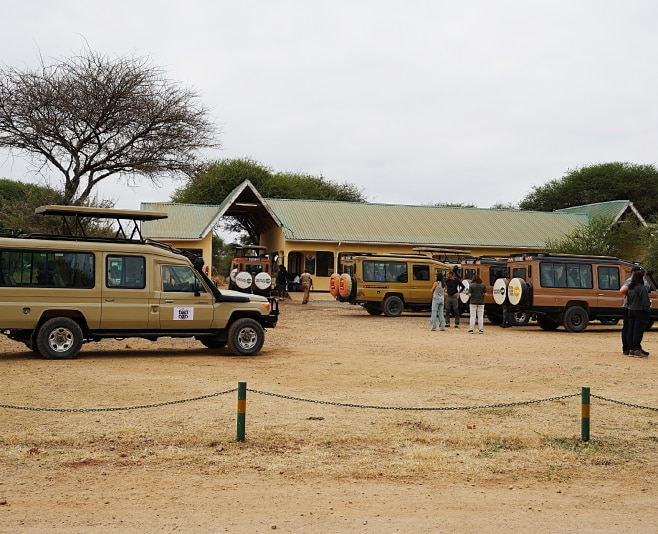
The park can be accessed by road or air.
What to do in Arusha national park?
Located at the base of Mount Meru, the Arusha National Park is smaller in comparison with other national parks in Tanzania, but it resembles a remarkably diverse and unforgettable park. Arusha National Park may be small, but it offers no shortage of exciting adventures thanks to its lush rainforests, crater lakes, and dramatic mountain views. When you are planning your itinerary and you are visiting Arusha National Park these are the top 9 things to do in Arusha National Park so that you do not miss out on all of the beauty of its nature and of its wildlife which is so lively.
1. Arusha national park Walking Safari
Arusha National Park walking safari is one of the uncanny experiences one would have in the park. Arusha National Park lets you explore by foot unlike many other Tanzanian parks where most of the activities are centered on game drives. Guided by an armed ranger, you will be able to discover forest tracks, meet giraffes at eye level, and enjoy sounds and views of the bush. It is a memorable experience of enjoying the wilderness of the park up close.
Note: All walking safaris must be conducted with an armed ranger and official park guide, as per TANAPA regulations, to ensure both visitor safety and wildlife protection

Walking Safari in Arusha National Park gives you a whole new and unique perspective of Tanzania´s wildlife and it truly is super exciting
2. Arusha National Park Wildlife Game Drives
One of the best things to do in Arusha national park is taking a classic safari. The park is very small, but there are more than plenty of wildlife giraffes, zebras, buffaloes, warthogs, waterbucks, bushbucks, and black and white colobus monkeys swinging out of the treetops, and more too. Although big predators such as lions are scarce here, there is still a variety of wildlife in Arusha National Park that makes each drive exciting and camera worthy.
3. Visit the Ngurdoto Crater
Nicknamed “Little Ngorongoro,” the Ngurdoto Crater is a spectacular volcanic caldera carpeted with swampy vegetation and surrounded by forested walls. It’s a great place to spot buffalo, warthogs, and monkeys, all framed by dramatic scenery. Walking trails along the crater rim provide stunning views into the lush basin below.
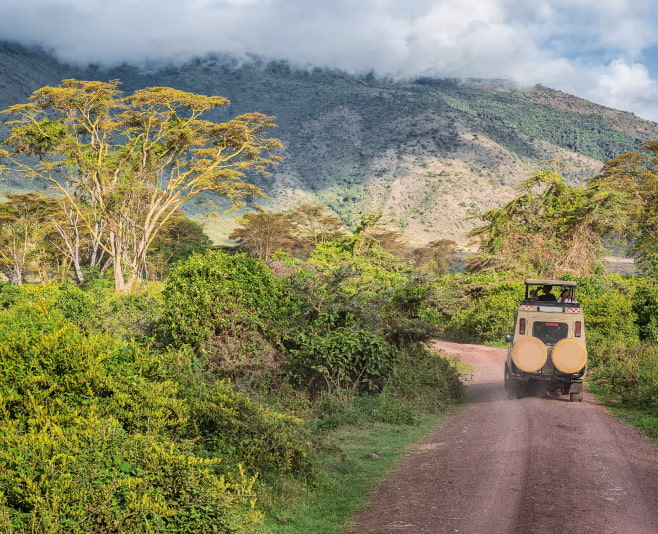
This verdant crater’s mossy, swampy habitat provides a natural sanctuary for elephants, buffalo and Colobus monkeys
4. Canoeing on Momella Lakes
To take a calm but adventurous session, canoeing would be an option in the Momella Lakes. Canoeing on the serene waters of the Momella Lakes is available during favorable weather conditions and may be restricted during the rainy season for safety reasons. The lakes host various types of water birds and are also a calm area to be admired by the natural beauty of the park.
5. Bird Watching
Arusha National Park is a dream destination to bird lovers and it is inhabited by more than 400 species of birds. There is dazzling diversity, including colorful trogons and turacos in the forest, and flamingos on the Momella Lakes. Take the opportunity to see some rare species in rich canopies or in the waterline while using your binoculars.
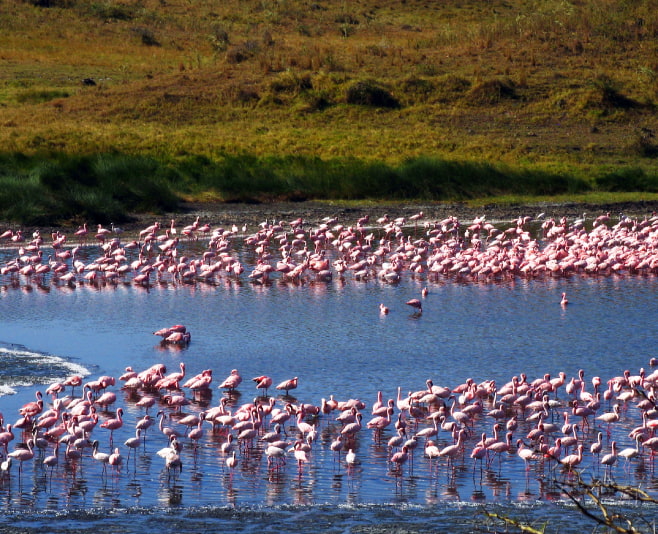
Arusha national park is one of the recognized birding areas in Tanzania hosting over 400 bird species, birds in the park include critically endangered species
6. Climb Mount Meru
Mount Meru is the second-highest mountain in Tanzania and it presents a multi-day hike with a difficult trail. The trail ascends through rainforest teeming with wildlife, ultimately leading to panoramic views across Kilimanjaro and adjacent plains. Climbing Mount Meru is a multi-day trek (typically 3 to 4 days) and not suitable for a day trip. However, it remains one of the top adventure experiences in Arusha National Park for well-prepared trekkers.
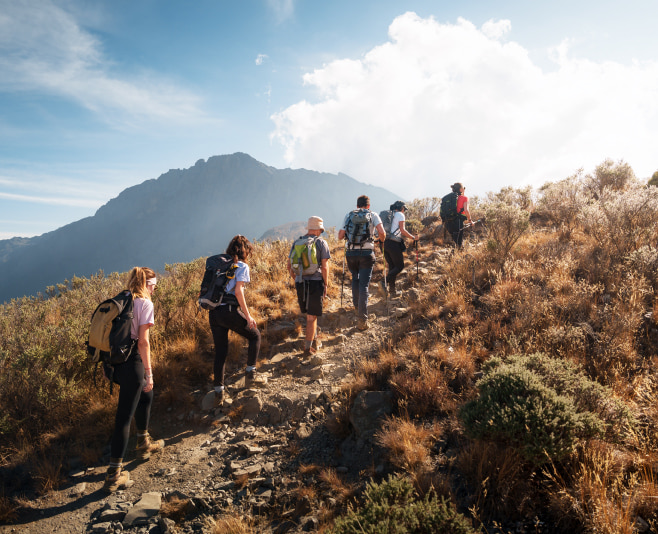
Despite being the second-highest mountain in Tanzania, the climb up Mount Meru is considered an alternate adventure
7. Discover the Momella Waterfall
Momella Waterfall is a scenic location, but it is set in the forest and may only be accessed by means of a guided walk. The trail will make you walk through thick vegetation and reward you with a refreshing scene of flowing water into a pool, surrounded with mossy rocks and chirping birds with it. It is an excellent supplement to your Arusha National Park walking safari.
8. Explore the Fig Tree Arch
Among the places to visit in Arusha National Park is one of the most distinctive and a must-see Fig Tree Arch. The Fig Tree Arch is a natural tunnel formed by a giant fig tree whose enormous roots create an arch big enough for a vehicle to pass through. It is an excellent photography location and has an ideal combination of both the art of nature and wildness of the park. Watched by beautiful vegetation and almost frequented by monkeys and birds, the Fig Tree Arch is an enchanted site that will give you the touch of pleasant surprise to your wonders around Arusha National Park.
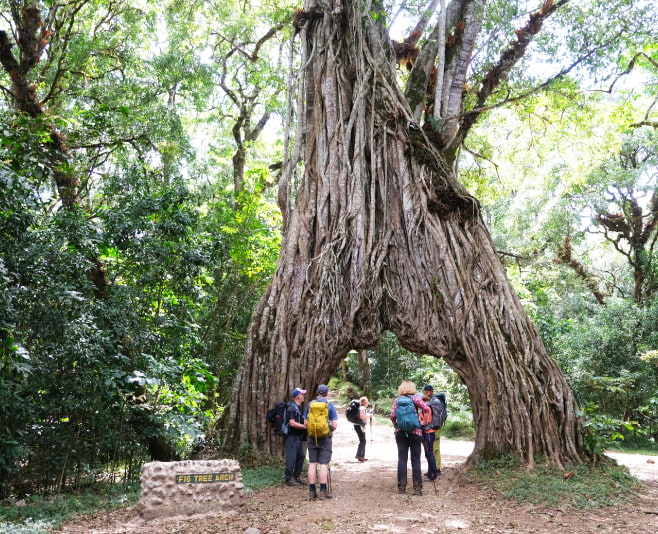
The Fig Tree Arch System is the largest and probably most popular tree in Tanzania
8. Tululusia Hill Hike
Tululusia Hill is a moderate hike that has a breath-taking panoramic view. The view at its peak is a wide scenery of Mount Kilimanjaro on a clear day, the lofty slopes of Mount Meru, and shining Momella Lakes. It is a great hike for people who need exercise, as well as a view.
9. Enjoy Camping Under the Stars
One of the most adventurous activities to engage in Arusha national park is camping. There are some official camping areas where you can camp and sleep in the open wind with the singing of birds and a sky full of stars. Major camping sites are located at the Momella Public Campsite and the Tululusia Special Campsite which is basic with amenities such as toilets and water point among others but offers a wilderness experience to the visitors. Camping here is memorable and it will wake up to the roar of monkeys or to a view of the mist spreading over the lakes. This is really a great method to enhance your bond with nature and experience the real Tanzanian safari.
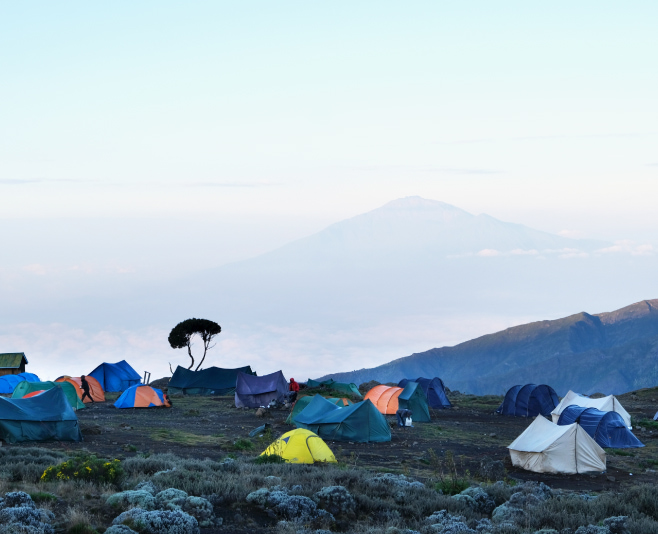
Arusha national park is one of the best camping sites in Tanzania
Practical Tips for Your Arusha National Park Day Trip
Arusha National Park is a fantastic day-trip safari destination in Tanzania, offering unique landscapes and wildlife. To make sure you have the best experience, here are some top tips for your visit:
1. Optimize Your Arusha national park Itinerary & Activities
- Plan for a Day Trip: Arusha national park is the ideal day trip. You are usually able to leave the city of Arusha early in the morning and be there late in the afternoon.
- Combine Activities: Game drives should not be the only thing you do. Arusha is among the Tanzanian parks where you can do a walking safari and canoeing in Momella Lakes. These are special activities that cannot be ignored at all. Your tour operator can reserve them in advance because they have different permits and guides.
- Focus on Specific Wildlife: While you won't see lions or rhinos, Arusha is famous for:
- Black-and-white colobus monkeys: These are striking primates which you should watch out for in the forest.
- Giraffes:You will find them in unusually large numbers on the open plains, making Arusha National Park one of the best places in Tanzania to observe these graceful animals.
- Flamingos: This lake is home of thousands of flamingos, beautiful birds.
- Buffalo and Zebras: Are found everywhere in the park.
2. What to Pack & Wear when visiting to Arusha National Park
- Layers are Key: The temperature can change during the day. Take breathable light clothing. It is necessary to pack a thin jacket or fleece to wear during the colder mornings and evenings particularly on the open-sided safari vehicles.
- Neutral Colors: Just wear greens, browns and khakis. Animal colors may at times scare animals.
- Comfortable Footwear: If you plan to do a walking safari, sturdy, comfortable closed-toe shoes are a must.
- Sun Protection: A wide-brimmed hat, sunglasses, and high-SPF sunscreen are crucial, as the African sun can be intense.
- Insect Repellent: Essential, especially if you're doing a walking safari or canoeing.
- Camera & Binoculars: Binoculars are indispensable for spotting distant wildlife. Bring a camera with a good zoom lens, extra batteries, and plenty of memory cards.
- Reusable Water Bottle: Your tour operator will provide bottled water, but a reusable one helps reduce plastic waste.
3. Preparing for Your Safari
- Book with a Reputable Tour Operator: To do a day trip, I recommend using a qualified safari company based in Arusha. They will cover park fees, transport, guide and even a picnic lunch. This makes it stress-free and without any trouble.
- Check what is included in your tour package: Verify what's included in your tour package (eg. park entrance costs, guide, vehicle, lunch food, things like cane paddle or walk).
- Be hydrated: make sure you take a lot of water. Your guide will avail bottled water.
- Follow Your Guide's Instructions: This will ensure your safety as well as the safety of the wildlife as they give instructions, particularly, during your game drive and during a walking safari. Stay in the vehicle unless instructed otherwise.
4. Essential Travel Documents for Tanzania
Passport Validity
Ensure your passport is valid for at least six months beyond your travel dates and has blank pages for visa stamps.
Tanzania Visa Requirements
Most visitors need a visa to enter Tanzania. You have two main options:
- Visa on Arrival: This service is provided at the principal entry points that include Kilimanjaro International Airport. The problem, however, is that queues are long and you should have cash (mostly USD) to pay the fee.
- eVisa (Online Visa): It is strongly suggested to use it due to its convenience. If you are willing to travel to Tanzania, you can obtain a Tanzanian eVisa upon getting access to the official government portal in advance. Processing typically takes 7–10 days, though some applications may be approved in as little as 3 days. Carry a printed version of your eVisa approval letter because an immigration officer may demand it on arrival.
Online application is faster and convenient to enter; it may be perfect in case you need to visit Arusha National Park immediately after visiting the airport.
Notes: Please carefully check official government web sites to find the most recent visa fees, requirements, and nationalities eligible:
Travel Insurance
Travel insurance is essential for visiting Tanzania. Choose a policy that covers:
- Medical emergencies: Including evacuation, especially if you plan activities like hiking Mount Meru.
- Trip cancellations or interruptions: Safaris and tours can be costly investments.
- Lost luggage or belongings.
- Adventure activities: Such as trekking or canoeing.
Remember to carry both printed and digital copies of your travel insurance policy and emergency contact numbers for peace of mind during your trip.
Conclusion
Arusha National Park is a hidden gem that provides a fantastic, accessible safari experience. Its diverse landscapes, unique wildlife, and opportunities for walking and canoeing make it a perfect choice for those with limited time or looking for something different from the traditional Big Five safari. A day trip to Arusha National Park offers a memorable slice of Tanzania's wild beauty, leaving you refreshed and amazed by its natural wonders.
Related Articles
- Top 15 Churches To Visit in Tanzania That Blend Beauty and History
- The Great Migration Tanzania Safari: A Complete Guide to the World’s Greatest Wildlife Show
- Ultimate Mtwara Tanzania Travel Guide: Best Things to Do and How to Plan Your Trip
- Tanzania Family Holiday Guide: Creating Memories That Last a Lifetime
- Tanzania Tourist e-Visa for First-Time Travelers: A Complete Online Application Guide











